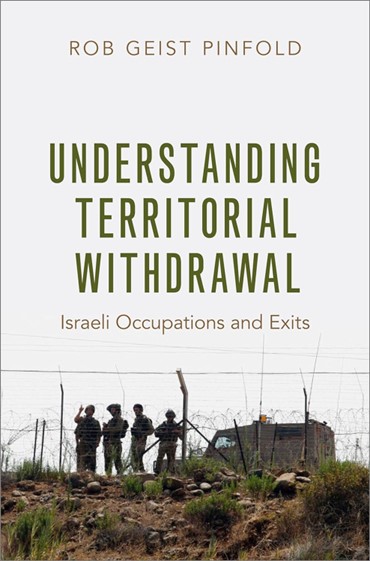Book Review - Understanding Territorial Withdrawal: Israeli Occupations and Exits

Understanding Territorial Withdrawal: Israeli Occupations and Exits by Rob Geist Pinfold. Oxford and New York: Oxford University Press, 2023. 344 pp., £54 hardcover 9780197658857
Rob Geist Pinfold’s Understanding Territorial Withdrawal: Israeli Occupations and Exits, is a timely contribution to the scholarly literature on territorial conflict and conflict resolution. It seeks to answer a number of important questions therein, namely why some territorial occupations end and others persist; why occupiers entrench in some territories but not others; and what causes domestic public opinion to turn “abruptly” against occupation. Taking readers through the varied history of Israeli occupations and withdrawals from territory beyond its 1949 de facto international borders, Pinfold offers detailed historical description and analysis of Israeli territorial policy vis-a-vis the Sinai Peninsula, Southern Lebanon, Gaza, the West Bank, and the Golan Heights from the watershed 1967 Six Day War to the present. These analyses are paired with thoughtful parallel case studies of American uneven withdrawals from Hispaniola, first the Dominican Republic in 1922 and finally Haiti in 1934.
 Examining concurrent domestic, bilateral, and international processes in all cases, this volume effectively demonstrates the extent to which each instance of withdrawal (in the former three cases as well as the American ones) and lack thereof (in the latter two) have been the product of rational and ultimately strategic evaluations of the perceived value and costs of occupation. The most important of these, Pinfold argues (p. 230) are (a) policy reassessment of the reasons justifying occupation, (b) unprecedented levels of violence from the occupied population, (c) bargaining with third parties to secure said withdrawal, (d) a pro-exit domestic consensus, (e) the presence of some responsible party to ensure withdrawal would not ultimately be unilateral, and (f) the ability to territorially entrench elsewhere to consolidate strategic gains from withdrawal.
Examining concurrent domestic, bilateral, and international processes in all cases, this volume effectively demonstrates the extent to which each instance of withdrawal (in the former three cases as well as the American ones) and lack thereof (in the latter two) have been the product of rational and ultimately strategic evaluations of the perceived value and costs of occupation. The most important of these, Pinfold argues (p. 230) are (a) policy reassessment of the reasons justifying occupation, (b) unprecedented levels of violence from the occupied population, (c) bargaining with third parties to secure said withdrawal, (d) a pro-exit domestic consensus, (e) the presence of some responsible party to ensure withdrawal would not ultimately be unilateral, and (f) the ability to territorially entrench elsewhere to consolidate strategic gains from withdrawal.
In doing so, Pinfold substantially challenges common approaches to these cases, which have tended to treat Israeli territorial policy as stagnant and unresponsive to changing circumstances (i.e. ideological and wholly irrational) or else in recent withdrawals (Southern Lebanon and Gaza) as unilateral retreat under fire. By examining the intriguing parallel interests, concerns, and intra- and inter-actor dynamics at play in American withdrawal from the Dominican Republic and Haiti, this volume also effectively demonstrates how similar concerns can drive and block territorial withdrawal, whether by an embattled small country or a quickly emerging world power (the United States prior to the Second World War).
Scholars who are deeply knowledgeable regarding the Israeli cases will find themselves nodding in agreement along with the author as he breaks down popular and academic myths regarding the processes by which Israel has or has not withdrawn from territory. Indeed, even the most self-confident experts should find they have something to learn from Pinfold’s well-constructed analysis and narrative. The chapter on the Sinai withdrawal is particularly superb, challenging simplistic and dated accounts of the processes by which the Israeli public and its policymakers were ultimately convinced to retrench from this territory: with its oil fields, military installations, and settlements. Pinfold’s demonstration of Israel’s careful coordination with the United Nations in its withdrawal from Southern Lebanon in exchange for security guarantees and global legitimacy, as well as detailing the important role played by the United States in enabling Israel’s withdrawal from Gaza, illustrate the extent to which neither withdrawal was entirely unilateral. Pinfold’s examination of non-withdrawal from the West Bank and the Golan Heights are similarly important in demonstrating how the absence of the conditions necessary for exit were lacking.
As with any work attempting to catalog and systematically explain multiple cases across multiple levels of analysis, Understanding Territorial Withdrawal has shortcomings. With its focus on costs and benefits of occupation to the occupier, albeit within the challenges of bargaining simultaneously within and between domestic, other state, and international audiences, much of the argument rests on the strategic value of holding territory. Yet military costs alone do not determine withdrawal outcomes. As Pinfold argues, whereas continued control of Southern Lebanon and Gaza was deemed ultimately strategically untenable, Palestinian violence in the West Bank, particularly in light of “lessons learned” in the former two territories, resulted in greater resolve and ultimately more effective counterinsurgency.
Pinfold acknowledges that this outcome is partially attributable to how different Israelis differently value the territories in question. This is clearly reflected in his careful analysis of Israeli parliamentary and party politics, political rivalries, and public opinion polling. What his domestic analyses neglect, however, is the powerful role played by both popular national beliefs and Israeli social movements (his examination of the Four Mothers Movement regarding Southern Lebanon aside) in constituting which territories have ultimately been deemed worthy of defending.
This is particularly true in the case of the West Bank. Here non-strategic beliefs about why the territory was important to the “Jewish” state, and not just defensively important to the “Israeli” one, are inseparable from key decisions about where to consolidate Israeli de facto control. Ultimately successful efforts by Israeli settlers to establish micro-settlements in the center of the historic quarter of Hebron, then the largest city in the West Bank, contrary to no such attempts in the other two largest Palestinian West Bank cities of Bethlehem and Nablus (“biblical” Shechem) are particularly notable. Furthermore, the absence of substantive discussion of the place of Jerusalem in Israel’s occupation-withdrawal conversation, despite rising popular Israeli understanding that the city will face some form of division or separate status in any peace settlement, is notable.
Turning northward, Pinfold is entirely correct to highlight Israeli skepticism of Syrian peace overtures in his analysis of non-withdrawal from the Golan Heights. In this respect, Anwar Sadat’s very public efforts to convince the Israeli public of his interest in a post-Yom Kippur War peace contrasts markedly with Hafez al-Assad’s refusal to signal the same. Yet this volume also overlooks the instrumental role played by the largely secular Golan Residents’ Committee in shaping the Israeli domestic consensus against withdrawal. The absence of such effective and affective public relations by the religious settlement movement, the most vocal opponents of the Gaza Disengagement and of West Bank withdrawal of any kind today, also helps explain why their settlement efforts, notably aside from the Etzion bloc and perhaps Maale Adumim, remain contentious in the Israeli public sphere whereas the Golan settlements are rarely given a second thought.
These limitations aside, Understanding Territorial Withdrawal represents an important contribution to the ongoing conversation on the problem of territorial occupations and exits. In making a distinct effort to engage with incentives and challenges in multiple policy arenas both to remain in and withdraw from territory captured in war, it offers a substantial degree of nuance missed by most studies, which tend to focus on the domestic, bilateral, or international alone. In the midst of Israel’s ongoing war with Hamas in the Gaza Strip, clear contextual lessons can be drawn from Pinfold’s analyses to understand what must be done, if there is any hope of convincing Israeli publics and policymakers of the need to avoid another prolonged Israeli occupation. As clearly demonstrated by his comparative analysis of American uneven withdrawal from Hispaniola, this volume’s strategic lessons also have substantial potential to travel, informing scholars and policymakers alike facing occupation challenges far beyond the Israeli context.
Ariel Zellman is a lecturer (assistant professor) in the Department of Political Studies at Bar-Ilan University. His research examines the causes of violent interstate and intrastate conflict, with a focus on nationalism, religion, and protracted territorial disputes. His recent book, Religious Minorities at Risk, with Matthias Basedau and Jonathan Fox was published by Oxford University Press in 2023. His academic articles have been published in American Politics Research, East European Politics, Journal of Conflict Resolution, Journal of Global Security Studies, Journal of Peace Research, Politics and Religion, Politics Religion & Ideology, Religions, Security Studies, Territory Politics Governance, and Terrorism and Political Violence.


